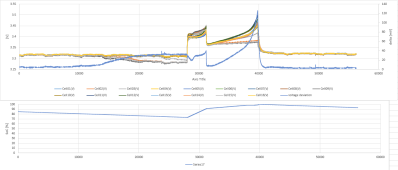Passive Balancing only burns off voltage from high cells, it does not transfer power like Active Balancing does. Passive is generally useless on large capacity cells as it can only burn off so many millivolts/milliamps "150mA(Max)" from their specs.
With PASSIVE Balancing, IF the cells are well matched for IR through the working voltage range, passive can keep cells balanced to below 20mv but due to the nature of LFP, fo Passive to be reasonably effective, it should start closer to 3.300 Volts per cell and continue to 3.450 which is just above the working voltage range. Remember that Passive only burn off high voltage, therefore as the battery pack charges this is addressed and causes no issues. Also by starting Passive ear;lier on, it takes the "edge" of the high cells making it easier to balance through teh cycle, rather than leaving it to deal with a larger imbalance if started later.
Active Balancing actually moves energy from High Cells to Low Cells and this is usually at a minimum of 1A to 5A depending on active balancer. Too many people start Active Balancing later which results in more work having to be done with a larger imbalance present. This creates a situation where active balancing has to work very hard and this is difficult if the imbalance is high. Again, starting Balancing at 3.300 with Active Balancing, does really keep the cells balanced during charge by addressing any "running" cells (those which gain charge faster) realtime. Again there is NO LOSS With Active Balancing, it is Transfered !
I have been performing assorted usage tests over the past few years with assorted Passive & Active Balancing systems be it within BMS or external. I have testied with 100AH systems to 280AH at all load levels including edge case testing to the extreme ends. The above information provided is a result of years of experience doing this.
Lastly, the Wives Tale to Clobber.
LFP has an Allowable Working Voltage, just like every other battery chemistry in existence. This ALLOWABLE range is from 2.500-3.650 Volts per cell, this is the range where there is no Harm/Damage caused. Below or Above that voltage range WILL cause harm to the cells, No If's And's or But's about it.
FYI: Gross Capacity measurements of a cells include the full "Allowable Range" and therefore if a 280AH cell is tested for gross capacity from 3.650 down to 2.500 it "should" test to between 290AH & 295AH
Net Capacity Tests that are performed by Manufacturers between the 3.000-3.400 volts per cell "working Range".
The LFP Working Voltage Range is what delivers the specified AH rating or call it NET AH for simplicity. That is the FLAT Voltage Curve from 3.000-3.400 Volts per cells with 3.200V being teh Nominal Voltage (and also 50% SOC). Most people will charge to 3.450V per cell which allows the cells to settle post charge input (LFP ALWAYS SETTLES) too 3.425 +/-. Discharge is perfectly safe to 2.800 or even 2.700 Volts per cell but below that can be tricky because the BMS has to recover to a point to allow charge. A deep discharge can easily take the battery down fast when low and you need to have it be able to recover enough to take charge without being cutoff for LVD.
See my Signature for more information inlcuding voltage charts and more.
Hope it helps, Good Luck.
BTW:
I run 3x280AH, 2x174AH (used EV LFP) and 1x105AH in one bank using JKbms with 2A Active Balancing.
Active Balancing starts at 3.300, cells are always within 40mv by the time they reach FLOAT which I have set at 3.400Vpc.
They are ALL under 10mv difference within 60 minutes of float if not less. When cells are colder (<20C/68F) they take a bit longer.
PS: Your EndAmps/TailCurrent for 280AH Battery Pack is 14A. Once the battery is only taking 14A Charge, it is full and ready to go into Float which finishes off the charging & topping.



